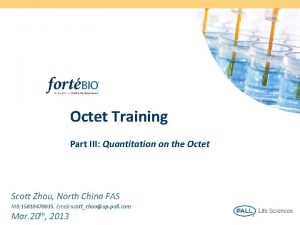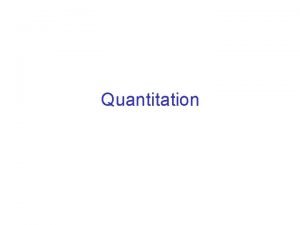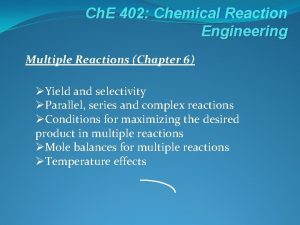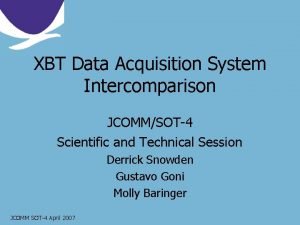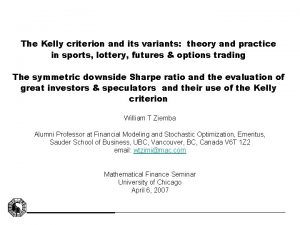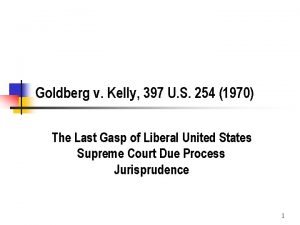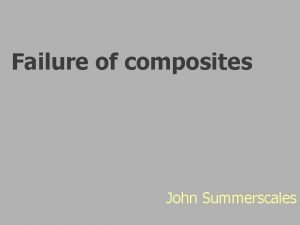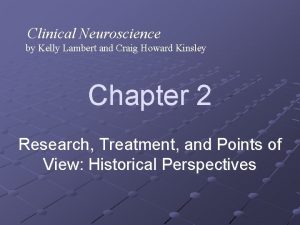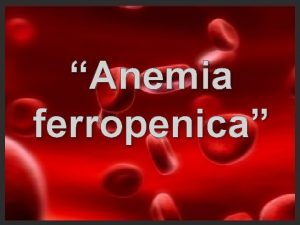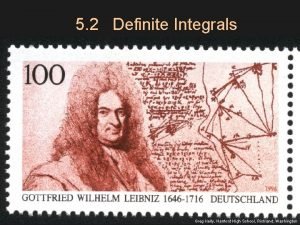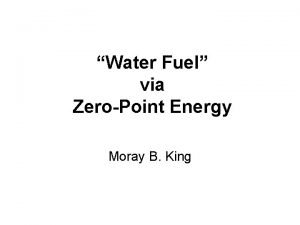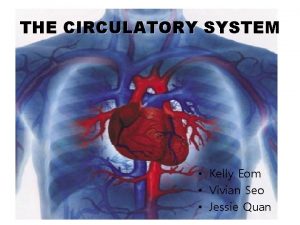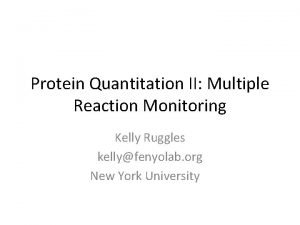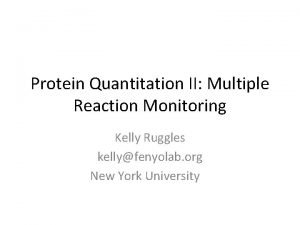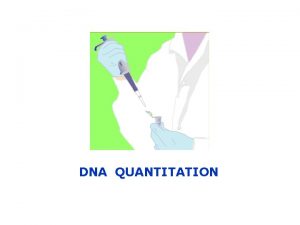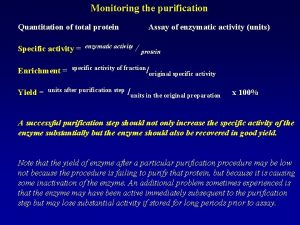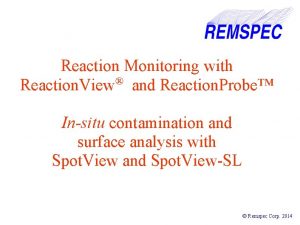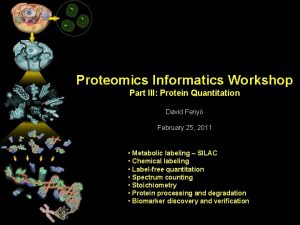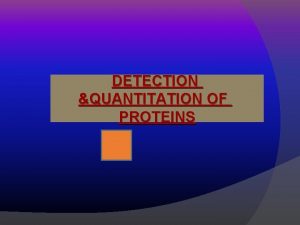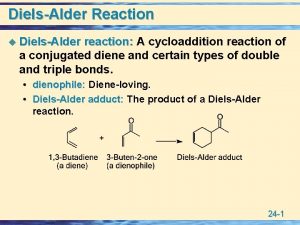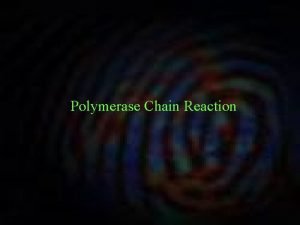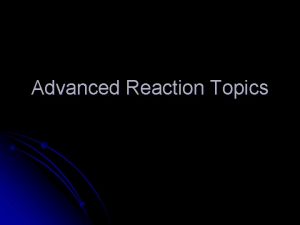Protein Quantitation II Multiple Reaction Monitoring Kelly Ruggles





























































- Slides: 61

Protein Quantitation II: Multiple Reaction Monitoring Kelly Ruggles kelly@fenyolab. org New York University

Lecture Outline • Protein quantitation using MS/MS • Basics of targeted proteomics • Motivating example: AKT and breast cancer

Lecture Outline • Protein quantitation using MS/MS • Basics of targeted proteomics • Motivating example: AKT and breast cancer

Proteomics “Quantitative analysis of proteins expressed in a cell at a time” – All components of a proteome • Global analysis completed 1 time • Discovery proteomics • Majority of proteomics papers use this technique – Dynamic changes in the proteome • Clinical assay • Proteome analyzed many times Haynes et al. (1998) Proteome analysis: biological assay or data archive? Electrophoresis 19: 1862 -1871

Proteomics “Quantitative analysis of proteins expressed in a cell at a time” – All components of a proteome • Global analysis completed 1 time • Discovery proteomics • Majority of proteomics papers use this technique – Dynamic changes in the proteome • Clinical assay • Proteome analyzed many times Haynes et al. (1998) Proteome analysis: biological assay or data archive? Electrophoresis 19: 1862 -1871

Discovery Proteomics Protein Identification in Shotgun Proteomics Computational issues with protein identification (1) Peptide Identification- using database search engines (2) Protein inference – identified peptides are assembled to a set of confident proteins (3) Result evaluation – reliability of these identifications Huang T et al (2012) Protein inference: a review

Discovery Proteomics Protein Identification in Shotgun Proteomics Computational issues with protein identification (1) Peptide Identification- using database search engines (2) Protein inference – identified peptides are assembled to a set of confident proteins (3) Result evaluation – reliability of these identifications Huang T et al (2012) Protein inference: a review

Protein Inference in Discovery Proteomics Computational issues with protein inference: • Generating a reliable list of proteins from identified peptides is not straightforward • ‘One hit wonders’ = some proteins only have a single peptide identified • Difficult to infer proteins based on a single peptide due to possible false-positives • Therefore multiple proteins can be supported by one peptides, and determining which it belongs to is difficult Examples: (1) Proteins 1 and 2 have same set of identified peptides, if no other supporting information then we cannot determine which protein is in the sample (2) Protein 3 is a one-hit wonder and cannot be reliably mapped (3) Protein 4 has two peptides identified which do not map to another protein, so we can assume that this protein is present Huang T et al (2012) Protein inference: a review

Using Discovery Proteomics to Map the Human Proteome • Shotgun discovery methods are robust but still significant issues (protein inference, reproducibility, FDR) • For clinical and biological assays, looking at all proteins in the organisms may not be the most useful approach • Need to focus instead on subset of proteins and ensure that we can achieve reliable and accurate quantitation

Proteomics “Quantitative analysis of proteins expressed in a cell at a time” – All components of a proteome • Global analysis completed 1 time • Discovery proteomics • Majority of proteomics papers use this technique – Dynamic changes in the proteome • Clinical assay • Proteome analyzed many times Haynes et al. (1998) Proteome analysis: biological assay or data archive? Electrophoresis 19: 1862 -1871

Traditional Affinity-based proteomics Using antibodies to quantify proteins RPPA Western Blot Immunohistochemistry ELISA Immunofluorescence

Using MS/MS for quantitative protein assays • Most clinical and biology studies in the literature rely on measurement of proteins which already have antibodies available • Goal of targeted proteomics is to create reliable, high quality assays to measure proteins that do not require antibodies and instead rely on MS/MS

Targeted Proteomics • Focuses on a subset of protein of interest – – – Disease related changes in proteins Signaling processes Highly multiplexed alternative method to western blots/antibodies Can focus on unique and informative peptides for protein of interest Hypothesis driven questions! Nature Method of the Year 2012

When to use targeted MS vs. global shotgun MS? Shotgun MS Targeted MS Identify limited number of proteins in maximum number of conditions Protein Identify maximum number of proteins in limited number of conditions r 2=0. 4698 RNA Kennedy JJ et al. , (2014) Nature Methods 11(2)

Lecture Outline • Protein quantitation using MS/MS • Basics of targeted proteomics • Motivating example: AKT and breast cancer

Mass Spectrometry based proteomic quantitation Shotgun proteomics 1. Records M/Z MS 2. Selects peptides based on abundance and fragments MS/MS LC-MS Targeted MS 1. Select precursor ion Digestion Fractionation Lysis MS 2. Precursor fragmentation MS/MS 3. Protein database search for peptide identification 3. Use Precursor-Fragment pairs for identification Data Dependent Acquisition (DDA) Uses predefined set of peptides

Targeted MS/MS • Selected/Multiple reaction monitoring • SWATH-MS: combines data independent acquisition and targeted analysis

Multiple Reaction Monitoring (MRM) • • Triple Quadrupole acts as ion filters Precursor selected in first mass analyzer (Q 1) Fragmented by collision activated dissociation (Q 2) One or several of the fragments are specifically measured in the second mass analyzer (Q 3)

MRM Instrumentation: Triple Quadrupole (Qq. Q)

Fragment Ion Detection

Peptide Identification with MRM Mass Select Precursor Fragment Mass Select Fragment Ion Q 1 Q 2 Q 3 Transition • Transition: Precursor-Fragment ion pair are used for protein identification • Select both Q 1 and Q 3 prior to run – Pick Q 3 fragment ions based on discovery experiments, spectral libraries – Q 1 doubly or triply charged peptides • Use the 3 most intense transitions for quantitation

Peptide Identification with MRM • Used for to analyze small molecules since the late 1970 s • More recently, used for proteins and peptide quantitation in complex biological matrices • Particularly for biomarker discovery • With small molecules, the matrix and analyte have different chemical natures so separation step is able to remove other components from analytes Separation MS analysis • With proteomics, both the analytes and the background matrix are made up of peptides, so this separation cannot occur Separation MS analysis

Strengths of MRM • Can detect multiple transitions on the order of 10 msec per transition • Can analyze many peptides (100 s) per assay and the monitoring of many transitions per peptide • High sensitivity • High reproducibility • Detects low level analytes even in complex matrix • Golden standard for quantitation!

Weaknesses of MRM • Focuses on defined set of peptide candidates – Need to know charge state, retention time and relative product ion intensities before experimentation • Physical limit to the number of transitions that can be measured at once – Can get around this by using time-scheduled MRM, monitor transitions for a peptide in small window near retention time

Parallel Reaction Monitoring (PRM) • Q 3 is substituted with a high resolution mass analyzer to detect all target product ions • Generates high resolution, full scan MS/MS data • All transitions can be used to confirm peptide ID • Don’t have to choose ions beforehand Peterson et al. , 2012

PRM Instrumentation: Quadrupole Time of Flight (Qqtof) The third quadrupole is replaced with a time of flight (TOF) mass analyzer offering high sensitivity, mass resolution and mass accuracy for both precursor and product ion spectra

Applications of MRM/PRM Metabolic pathway analysis Protein complex subunit stoichiometry Phosphorylation Modifications within protein Biomarkers: protein indicator correlating to a disease state Can enrich for proteins/peptides using antibody

Lecture Outline • Protein quantitation using MS/MS • Basics of targeted proteomics • Motivating example: AKT and breast cancer

MRM Workflow Define protein set Clinical/Biological Question Selection of peptides Proteotypic LC and MS properties Selection of transitions Intensity of transitions MS Validation of transitions Interferences Protein Quantitation

MRM Workflow Define protein set Clinical/Biological Question Selection of peptides Proteotypic LC and MS properties Selection of transitions Intensity of transitions MS Validation of transitions Interferences Protein Quantitation

Define the set of proteins based on a biological question

MRM Workflow Define protein set Clinical/Biological Question Selection of peptides Proteotypic LC and MS properties Selection of transitions Intensity of transitions MS Validation of transitions Interferences Protein Quantitation

Selecting Peptides • A few representative peptides will be used to quantify each protein • Need to fulfill certain characteristics – Have an unique sequence – Consistently observed by LC-MS methods – 8 -25 amino acids – Good ionization efficiency – m/z within the range of the instrument – No missed cleavages – Not too hydrophillic (poorly retained) or hydrophobic (may stick to column)

Identifying Proteotypic Peptides Step 1: Full protein sequence in FASTA format Set of Proteins Trypsin Peptides Step 2: Tryptic Peptides Ref. Seq Ensembl Uniprot Proteotypic Peptides PTPIQLNPAPDGSAVNGTSSAETNLEALQK LEAFLTQK PSNIVLVNSR LEELELDEQQR DDDFEK…. . Step 3: Compare to human reference database -Contain all peptide sequences -Find all peptides that only map back to one gene Match peptide to proteins (Reference Protein DB) Match proteins to genes (Using protein names and genomic DB)

LC/MS Properties: GPMDB -Compares peptides to a collection of previously observed results -Determines how many times the peptide has been observed by others -Most proteins show very reproducible peptide patterns

LC/MS Properties: Skyline -Compares peptides to MS/MS spectral library -Predicts most abundant transitions

MRM Workflow Define protein set Clinical/Biological Question Selection of peptides Proteotypic LC and MS properties Selection of transitions Intensity of transitions MS Validation of transitions Interferences Protein Quantitation

Selecting Transitions • Limitation of MRM-MS: ~1 -2 m/z unit window for precursor and fragment ion occasionally let in interfering peptides with similar characteristics • If we want to use these transitions for quantitation, we need to be confident there are no interferences • Largest always largest, smallest always smallest etc. • b-fragments of high m/z are less represented on Qq. Q MRM

Selecting Transitions • Limitation of MRM-MS: ~1 -2 m/z unit window for precursor and fragment ion occasionally let in interfering peptides with similar characteristics • If we want to use these transitions for quantitation, we need to be confident there are no interferences • Largest always largest, smallest always smallest etc. • b-fragments of high m/z are less represented on Qq. Q MRM Peptide of interest Interfering peptide

Selecting Transitions: SRMCollider • Input peptides of interest • Determines the m/z values for transition pair • Simulates a typical SRM experiment • Predicts fragment intensities and retention time information for input peptide • Compares the transition to all other transitions in a background proteome • Outputs the number of predicted interferences for each transition for that peptide Input peptide sequence Choose peptides that have at least one transition with zero interferences

Selecting Transitions: Skyline • Can use to find best transitions to pick – Intensity (rank) – Dot product (similarity to reference spectra) Want high rank and dotp close to 1

MRM Workflow Define protein set Clinical/Biological Question Selection of peptides Proteotypic LC and MS properties Selection of transitions Intensity of transitions MS Validation of transitions Interferences Protein Quantitation

Validating Transitions: “Branching ratio” Branching Ratio (BR): ratio of the peak intensities Light (Analyte) I 1 I 2 Heavy(SIS) I 1 I 3 I 2 IAx, IBx : Peak areas of Analyte IAx. S, IBx. S : Peak areas of SIS n=number of SIS transitions Kushnir, 2005

Validating Transitions: Au. DIT • Au. DIT: Automated Detection of Inaccurate and imprecise Transitions • Uses “branching ratio” 1. Calculate relative ratios of each transition from the same precursor 2. Apply t-test to determine if relative ratios of analyte are different from relative ratios of SIS http: //www. broadinstitute. org/cancer/software/genepattern/modules/Au. DIT. html.

Validating Transitions: Au. DIT Blue: Light Red: Heavy Relative product ions should have a constant relationship Abbatiello, 2009

PRM Workflow MRM PRM Target Selection of peptides Selection of transitions MS Selection/ Validation of transitions Protein Quantitation

Finding Interference using simple and complex matrices: CRAFTS • PRM and MRM are most useful when quantifying protein in a complex matrix – Tumor lysate – Plasma • Simple, reference matrix (buffer) should have no interferences • Compare the transitions in complex to those in simple • Ratio close to 1 indicates low interference

CRAFTS algorithm for PRM-MS

CRAFTS algorithm for PRM-MS

CRAFTS algorithm for PRM-MS

CRAFTS algorithm for PRM-MS

PRM Workflow MRM PRM Target Selection of peptides Selection of transitions MS Selection/ Validation of transitions Protein Quantitation

Label-free quantitation • Usually use 3 or more precursor-product ion pairs (transitions) for quantitation • Relies on direct evaluation of MS signal intensities of naturally occurring peptides in a sample. • Simple and straightforward • Low precision • Several peptides for each protein should be quantified to avoid false quantitation

Stable Isotope Dilution (SID) Lysis Fractionation Digestion Light LC-MS L H MS • Use isotopically labeled reference protein • 13 C and/or 15 N labeled peptide analogs • Chemically identical to the target peptide but with mass difference Synthetic Peptides • Add known quantity of heavy standard (Heavy) • Compare signals for the light to the heavy reference to determine for precise quantification

Quantitation Details L Analyte H MS SIS: Stable Isotope Standard PAR: Peak Area Ratio SIS PAR = Light (Analyte) Peak Area Heavy (SIS) Peak Area Analyte concentration= PAR*SIS peptide concentration -Use at least 3 transitions -Have to make sure these transitions do not have interferences

Open Source MRM analysis tools

SWATH-MS: Data Collection • Data acquired on quadrupole-quadrupole TOF high resolution instrument cycling through 32 -consecutive 25 -Da precursor isolation windows (swaths). • Generates fragment ion spectra for all precursor ions within a user defined precursor retention time and m/z • Records the fragment ion spectra as complex fragment ion maps 32 discrete precursor isolation windows of 25–Da width across the 400 -1200 m/z range Gillet et al. , 2012

SWATH-MS: Data Analysis Complete mass fragment spectra 1. 2. 3. From spectral libraries, find fragment ion maps for peptides of interest Mine the SWATH data for these spectra Extract fragment ion traces for quantification Endogenous (open) and reference peptide (closed) y 4/y 10 fragments Gillet et al. , 2012

SWATH-MS Fragment Ion Interferences 0 0 0 MRM SWATH Low Resolution No isolation window Instruments Gillet et al. , 2012

Summary • Targeted proteomics can be used as an alternative to antibody-based protein assays in hypothesis driven biological experiments. • Allows for multiplexed analysis of many proteins in different conditions. • PRM removes the step of transition validation and allows for all computational analysis post-acquisition. • SWATH removes the step of peptide selection and generates transitions for all precursor ions in the defined precursor retention time and m/z • Transition interference must be appropriately identified prior to protein quantitation. • Several computational tools to predict and identify interferences in MRM and PRM have been developed.

Questions?
 Kelly ruggles
Kelly ruggles Octet red 96
Octet red 96 Quantitation
Quantitation Stanley miller
Stanley miller Channel vs carrier proteins
Channel vs carrier proteins Protein-protein docking
Protein-protein docking Kelly criterion example
Kelly criterion example Baseline
Baseline Shared memory mimd architecture
Shared memory mimd architecture Chemical reaction engineering
Chemical reaction engineering Unit of rate of reaction for first order reaction
Unit of rate of reaction for first order reaction Addition reaction and substitution reaction
Addition reaction and substitution reaction Leukoerythroblastic reaction vs leukemoid reaction
Leukoerythroblastic reaction vs leukemoid reaction Half time equation
Half time equation Kelly magelis
Kelly magelis Therapeutic riding lesson plan examples
Therapeutic riding lesson plan examples Kraigher kristofferson
Kraigher kristofferson Kelly ann naylor
Kelly ann naylor Kelly mc hills
Kelly mc hills Fractional kelly criterion
Fractional kelly criterion Classic vs exertional heat stroke
Classic vs exertional heat stroke Combination syndrome
Combination syndrome Kelly groddy ncaa
Kelly groddy ncaa Kelly gallagher write like this
Kelly gallagher write like this Dr claire kelly
Dr claire kelly Kelly monaco scuba diving accident
Kelly monaco scuba diving accident Kelly sule
Kelly sule Edward thorp kelly criterion
Edward thorp kelly criterion Kelly hoppen born
Kelly hoppen born Kelly aman
Kelly aman Kelly pollitt
Kelly pollitt Kelly perales
Kelly perales Kelly king dibble
Kelly king dibble Kelly reidell
Kelly reidell Goldberg v. kelly
Goldberg v. kelly Fixed role therapy kelly
Fixed role therapy kelly Organization corollary example
Organization corollary example Kelly tyson
Kelly tyson Kelly forese
Kelly forese Elements of short story
Elements of short story Kelly collett
Kelly collett Kelly proctor dnv
Kelly proctor dnv Curley's wife description
Curley's wife description Kelly scott french
Kelly scott french [email protected]
[email protected] Is kelly clarkson a neuroscientist
Is kelly clarkson a neuroscientist Joe fox tom hanks
Joe fox tom hanks Statement of owner's equity example
Statement of owner's equity example Kelly reidell
Kelly reidell Walden iop
Walden iop Causas de la anemia ferropenica
Causas de la anemia ferropenica Greg kelly calculus
Greg kelly calculus Kelly consulting closing entries
Kelly consulting closing entries Kelly consulting closing entries
Kelly consulting closing entries Kelly vs crile forceps
Kelly vs crile forceps What sees
What sees Importance of philosophy ppt
Importance of philosophy ppt Youtube.com
Youtube.com Kelly eom
Kelly eom Non aaawwubbis sentences
Non aaawwubbis sentences Plummer vinson syndrome
Plummer vinson syndrome Kelly's cognitive approach to personality
Kelly's cognitive approach to personality

